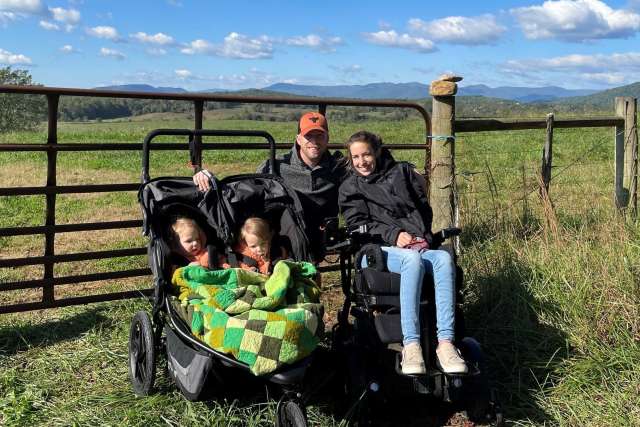Dani Izzie was not ready to consider complex urological reconstruction shortly after the spinal cord injury that left her quadriplegic.
“At that point, my mindset was still, ‘I want to get better and walk again,’” says Izzie, who was 22 when she slipped in a restaurant bathroom and fell in such a way that she broke her neck. “The idea of having such a massive surgery, rerouting my plumbing and changing my body forever was like, no, I’m not going to do that. No way.”
But after a year of depending on her parents and caregivers to catheterize her every time she had to urinate — an obviously intimate and intrusive experience — Izzie reconsidered the surgery known as the Mitrofanoff procedure, which she underwent in 2010. Afterward, her world began to re-open in ways she had only dreamed about.
“It was completely life-changing,” Izzie says. “It set me on a trajectory to be where I am today, to be able to live a normal life, to live independently, to pursue a career, to not have to have somebody with me 24/7, to have my dignity, to have my family and have babies.”
What is the Mitrofanoff procedure?
Izzie did countless hours of research before meeting with UCLA Health urologist Ja-Hong Kim, MD, an associate professor in the division of pelvic medicine and reconstructive urology at the David Geffen School of Medicine at UCLA, to discuss bladder surgery.
“She came very well-prepared,” Dr. Kim recalls. “She understood the risks and benefits.”
Because of Izzie’s spinal cord injury, her brain and her bladder were no longer communicating, which meant she needed to use a catheter to urinate. But because her disability limits the mobility of her arms and hands, she was unable to reach her urethra to tend to the catheter herself.
The Mitrofanoff procedure creates a new tube in the stomach through which a person can urinate with a catheter. Dr. Kim was able to hide the opening, or stoma, in Izzie’s belly button, so she could access the catheter herself without any external signs it was there. Even in a bikini, no one would notice.
“It opened so many doors,” Izzie says. “There’s so many other barriers out there when you have a disability as complicated as mine, and just to have that one barrier removed, it was huge.”
Independence regained
A few weeks after having the procedure, Izzie decided to put her new independence to the test — she planned to spend the night at a friend’s house on New Year’s Eve.
“At the time, I was like 24, so I wanted to have fun and party, and it was just amazing to be able to do that,” Izzie says. “The alternative would have been that I would have had to use paratransit, which doesn’t operate past 9 p.m., and go home early and spend the evening by myself.”
Not needing assistance to empty her bladder also meant Izzie could go to graduate school and get a job — things that previously would have been impossible without a caretaker’s constant presence. “I just could not imagine what that would look like or how that would work or how I would pay for it,” she says.
It meant she could date without having to explain extremely personal matters right away, which “allowed me to be myself and allowed the other person to really get to know who I was without the first thing being like, ‘Well, these are my nursing needs,’” she says.
It also allowed her to travel more easily, including to Italy, where her mother is from and where Izzie holds dual citizenship. “That got robbed when I got injured — I couldn’t go to my second home,” Izzie says. Traveling as a wheelchair user is already challenging, she says, but trying to make that long flight without using the bathroom would have been inconceivable.
“You can see how big everything that was restored was for me,” she says, “which is why I’m such a big advocate for this surgery if it’s an option for people in my situation.”
Starting a family
A few years post-surgery, Izzie (nee Schirmer) was living in California and visiting Washington, D.C., when she met the man who would become her husband, Rudy. They went on a few dates, and before she left to return home, he asked her to be his girlfriend.
“I was like, ‘Are you crazy? I live thousands of miles away!” she recalls.
But he was serious and they began a long-distance relationship that saw them taking turns traveling cross-country every month. Finally, it became clear that one of them needed to relocate. Izzie decided to move east. Shortly thereafter, while on a trip to Italy, he proposed.
The couple knew they wanted to have a family, so Izzie dug back into doing research. What would pregnancy be like for someone with her disabilities?
“I had a lot of fears, especially around how a pregnancy would impact my health, during and then after,” she says. “I was definitely concerned about the Mitrofanoff — I didn’t want to mess it up, just given how important it really is to my life.”
She found a few personal stories online from people with the Mitrofanoff procedure who’d given birth. She also reached out to Dr. Kim to make sure it was OK.
This was all before she and Rudy learned they were expecting twins.
“Once we knew it was twins, I actually truly became high-risk, because apparently that’s more high-risk than the quadriplegia,” Izzie says.
Still, she was able to successfully use the Mitrofanoff throughout the pregnancy, though sometimes she had to rearrange the babies in her belly to reach the stoma. The goal was for Izzie to deliver the babies vaginally, she says. But just as the COVID-19 pandemic began raging, she went into premature labor at 33 weeks.
In the delivery room, doctors discovered that the first baby was breech, instead of coming through the birth canal head first, so Izzie was rushed to the operating room. Their daughters were born via C-section in April 2020.
“The Mitrofanoff was the least of my issues,” Izzie says.
New beginnings
Since becoming a mom, Izzie has done nationwide advocacy around disabled pregnancy and parenting. Early in her pregnancy, she and Rudy agreed to be the subjects of a documentary, released in 2022, “Dani’s Twins.”
“The reason I ended up doing it was because there was just so little information out there — I mean, there’s some clinical information about pregnancy for people with spinal cord injury, but I just still couldn’t grasp what it would be like from a personal, human-person perspective. And especially with twins, there was, like, nothing,” she says. “I said I think this is really going to benefit people in my community, so I just did it.”
“I signed up for it before I realized there was going to be a pandemic,” she adds.
With the release of the film, Izzie has appeared around the country to discuss not just the medical aspects of pregnancy with a spinal cord injury, but social and political aspects as well. She continues to moderate a private support group for quadriplegic women called “The Quad Squad,” which has nearly 500 members.
In 2023, Izzie also became an entrepreneur. After a decade doing social media and marketing for a company that manufactures wheelchair wheels, Izzie branched out on her own and launched Access Social, which she describes as “a very small but mighty social media agency that specifically focuses on disability-inclusive campaigns and clients.”
Reflecting on the early days post injury when she hoped the Mitrofanoff procedure might restore some normalcy and independence to her life, Izzie rejoices in how far she’s come and all she’s created.
“I feel very lucky,” she says. “I feel very, very grateful and blessed.”




